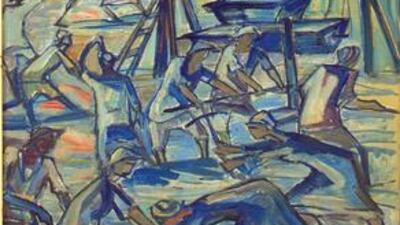If you only see one exhibition this year, make it Re:Orient, which covers three decades of political and sociocultural transition in the Arab world through the lens of visual art.
Whether it is the construction of the Aswan Dam, the agricultural crisis in Syria or simply a snapshot of street life of at a time when the Arab world was undergoing a great period of change, the collection of the Barjeel Art Foundation offers a unique window onto the social conversations between the 1950s and 1970s.
“This was a pivotal period of history in the Arab world,” says Mandy Merzaban, the collections manager and curator at Barjeel. “This was the time the Arab world was at its prime and you get a glimpse of that in this exhibition.”
Almost every piece in the show could be considered a masterpiece in its own right due to the sheer depth of the story. Walking through the works is like a condensed history lesson about the entire region.
The first piece, given a prominent position at the entrance of the gallery, is Gazbia Sirry’s Women Talking. The only piece by a woman in this show, the painting signifies a time during the career of the Egyptian artist when she was moving towards an abstract style.
“This piece is very poignant,” explains Merzaban. “We have given it importance because it is monumental and a big chunk of the show hinges on her transition that reflects this transitional period.”
In the small room to the right is a collection of paintings by the Iraqi artist Dia Azzawi as well as a sculpture by Ismail Fattah. Fattah is best known for designing Nusb Al-Shahid (Monument of the Martyr) in Baghdad, a public artwork commissioned in the early 1980s to commemorate fallen soldiers of the 1980-88 Iran-Iraq War. His earlier, more figurative piece seen here is interesting because it shows a freedom that artists had in the 1950s and 1960s in Iraq before the government became involved in the art scene and began using artists for propaganda.
In the centre of the main hall is Ragheb Ayad’s painting entitled Assouan. Thought to be one of many pieces commissioned by artists to document the building of the Aswan Dam, its very subject matter represents perhaps the greatest project of Arab nationalism at the time. In his magnificent painting, the focus is on the details of the workers, which become part of the machine that is creating the dam.
“Intimate details of daily life can be seen in many of the pieces in the exhibition,” says Merzaban. “They are critical to our understanding of that period.” Close inspection of the canvases also reveals elements that might go unnoticed by the general observer. In The Icons of Moudarres, by Fateh Moudarres, a piece worth around US$1 million (Dh3.67m), the characters are short and stocky.
Moudarres, a Syrian who is considered to be a leader in the field of Arab modernism and also studied at the Accademia di Belle Art in Rome, was living in a rural area but moved to Damascus at the time of the Syrian agricultural crisis. His characters therefore take on the cramped feel that he would have experienced upon making this move and the painting takes on socio-historical relevance.
Hafiz Droubi’s Watermelon Sellers, in which the influence of cubism can clearly be seen, is flanked by Seif Wanly’s Nocturne and Russian Ballet pieces that also pick up this thread of influence.
“The wide range of artists here were not just artists but scholars and academics and they were well-travelled. If you look at their work you realise that they are not only just influenced by Europe and styles they learnt there, they also had an interest in their own local culture, mythology and folklore and all the cultural aspects of their home countries,” says Merzaban.
In the final room, Issam Al Said’s calligraphic piece is a reminder of this artist’s fascination with the relationship between science and Islam. But look a little deeper and references to the assassination of his father Nuri Al Said (who was the former president of Iraq) might also be drawn.
Furthermore, Ahmed Nashaf Al Zuaby’s illuminated painting of a Syrian hammam also has spiritual connotations, as it discusses not just the cleansing of the body but also of the soul.
On the way out of the exhibition, take a moment to watch a medley of film clips taken from old black-and-white Egyptian movies and see the optimism and creativity of the region come to life.
There is no easy way to sum up Re:Orient other than the fact that it tells so many stories in one room that you are bound to leave enriched.
• Re:Orient runs until November 22 at Barjeel Art Foundation, Sharjah. Visit www.barjeelartfoundation.org for details

